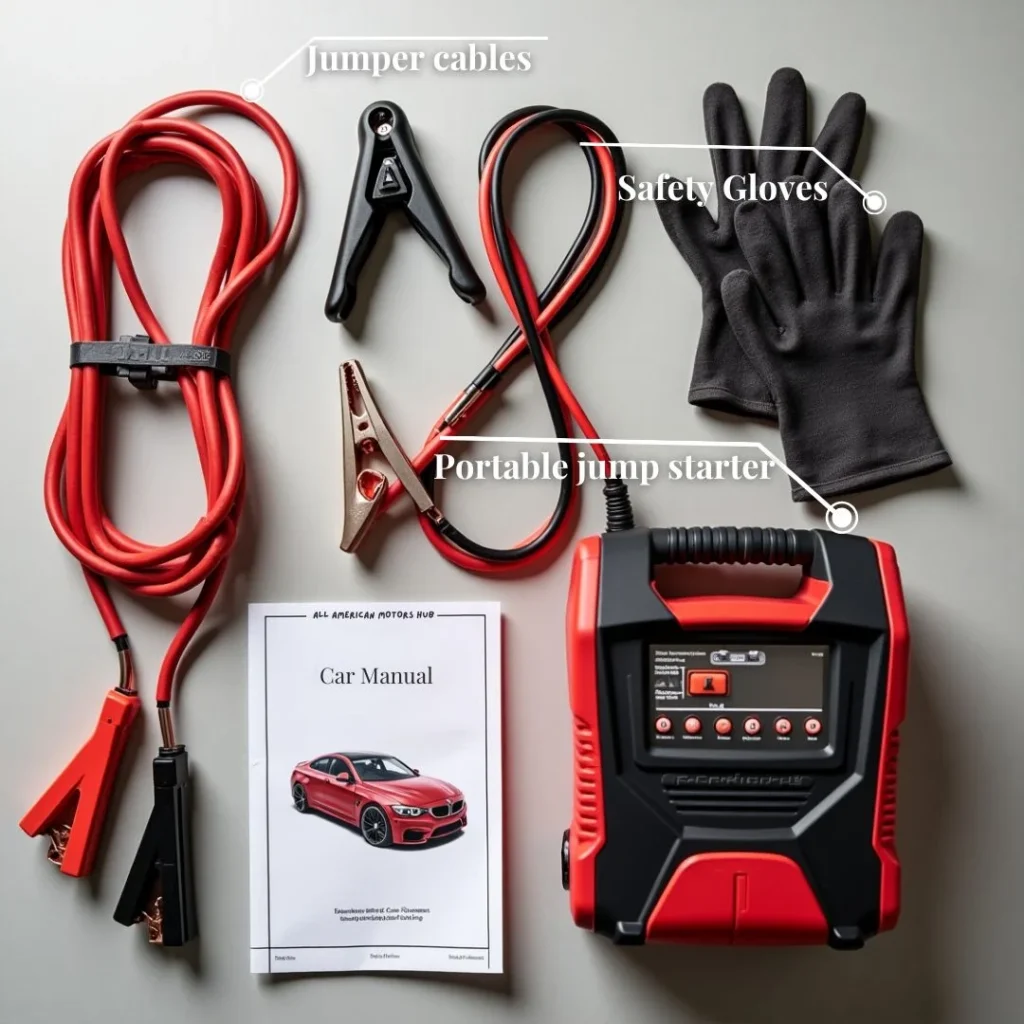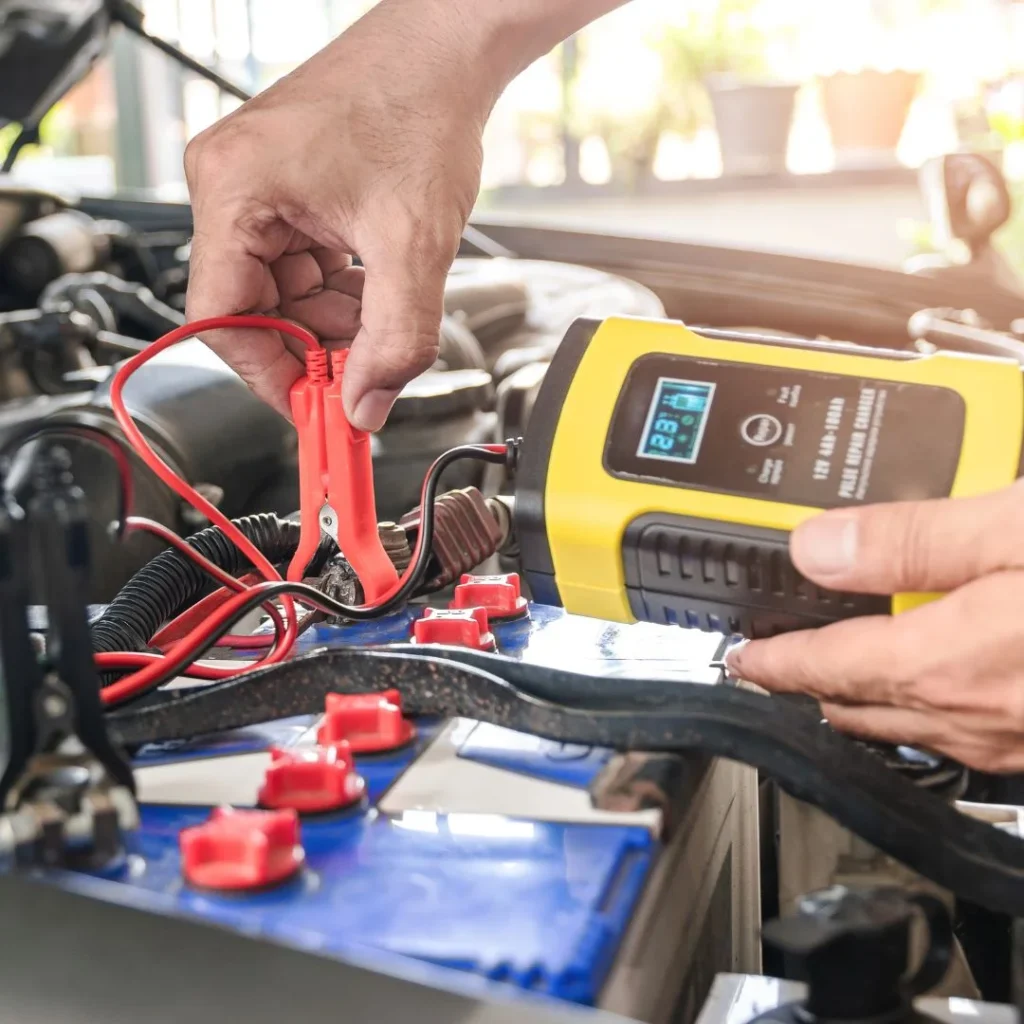Table of Contents
Knowing how to jump start a car is one of those essential life skills that can save you from being stranded in a parking lot, on a lonely road, or during an emergency. Whether you left your lights on overnight or your battery died in freezing weather, a dead car battery always seems to happen at the worst possible time. Learning the proper way to jump start a car with cables can get you back on the road quickly and safely.
Every driver should understand the basics of jump starting a car with cables. It’s not complicated, but doing it wrong can damage your vehicle’s electrical system or even cause injury. This guide will walk you through each step clearly and simply, so you’ll feel confident the next time you or someone else needs a jump. Plus, we’ll cover important safety tips, troubleshooting advice, and alternative solutions when traditional jumper cables aren’t an option.
Step-by-Step Guide to Jumpstart Your Car
What You’ll Need to Jump Start a Car
| Item | Purpose |
| Jumper cables | Connects dead battery to a live power source |
| Another running vehicle | Supplies power to boost dead battery |
| Safety gloves | Protects hands during the connection process |
| Car manual | Reference for battery location & terminal details |

Step 1: Prepare the Cars and Safety Checks
Before you start connecting any cables, take these important preparation steps:
- Park the working car close to the dead car, but make sure they’re not touching
- Turn off both engines completely
- Set both parking brakes firmly
- Turn off all accessories (radio, lights, air conditioning)
- Pop both hoods and locate the batteries
- Check the dead battery for visible damage, cracks, or leaks. Proper car engine maintenance can help avoid battery and performance issues.
- If you see any damage, don’t attempt to jumpstart – call for professional help
Safety tip: Always wear safety glasses if available, and never smoke or use open flames near car batteries.
Step 2: How to Connect Jumper Cables
The order you connect jumper cables matters. Follow these steps exactly to avoid sparks or damage:
- Red to dead positive: Connect one red clamp to the positive (+) terminal of the dead battery
- Red to good positive: Connect the other red clamp to the positive (+) terminal of the working battery
- Black to good negative: Connect one black clamp to the negative (-) terminal of the working battery
- Black to ground: Connect the final black clamp to an unpainted metal surface on the dead car’s engine block (not the battery)
Important: That last connection should be away from the battery to prevent sparks near potentially explosive battery gases, just like a properly functioning ignition coil guide ensures safe starting
Step 3: Starting the Car
Now comes the moment of truth:
- Start the working car and let it run for 2-3 minutes
- Rev the engine slightly (to about 1,500 RPM) to charge the dead battery
- Try starting the dead car
- If it doesn’t start immediately, wait another 2-3 minutes and try again
- Once the dead car starts, let both vehicles run for at least 5 minutes
Don’t panic if the car doesn’t start right away. Sometimes severely drained batteries need a few extra minutes of charging.
Step 4: Removing Cables Safely
Remove the cables in the exact reverse order you connected them:
- Remove the black clamp from the ground (engine block) on the formerly dead car
- Remove the black clamp from the negative terminal of the good battery
- Remove the red clamp from the positive terminal of the good battery
- Remove the red clamp from the positive terminal of the formerly dead battery
Keep the revived car running for at least 20 minutes, preferably by driving it around. This allows the alternator to fully recharge the battery.
Tips & Safety Precautions
Do’s:
- Read your owner’s manual first – some cars have specific jump-starting instructions
- Check that both batteries have the same voltage (usually 12V)
- Keep jumper cables untangled and organized
- Stand clear when starting either vehicle
- Drive the jumped car for at least 20 minutes afterward
Don’ts:
- Never connect positive to negative terminals (this causes dangerous sparks)
- Don’t attempt to jumpstart a frozen or damaged battery
- Never lean over the battery while making connections
- Don’t touch the clamps together when they’re connected to a battery
- Avoid jumpstarting in the rain unless absolutely necessary
Troubleshooting: What If the Car Still Won’t Start?
If your car won’t start after following these steps, consider these possibilities:
Wait longer: Some batteries need 10-15 minutes of charging before they’ll start
Check connections: Ensure all clamps are making solid contact with clean metal
Clean the terminals: Corrosion on battery terminals can prevent good connections. Try cleaning them with a wire brush or cloth
Bad alternator: If the car starts but dies again quickly, your alternator might not be charging the battery, which can also affect used engines over time.
Dead battery: If the battery is completely dead or too old, it might not hold a charge anymore
Other issues: The problem might not be the battery – consider fuel, starter, or ignition problems
Alternative Solutions to Traditional Jumper Cables
Portable Jump Starters
These compact devices are lifesavers when you’re alone. They’re basically batteries you can carry in your trunk that provide enough power to start your car. No second vehicle needed!
Roadside Assistance
Services like AAA or your insurance company’s roadside program can send someone to jumpstart your car professionally. This is especially helpful if you’re uncomfortable doing it yourself.
Battery Replacement
If your battery dies frequently, it’s probably time for a new one. Most batteries last 3-5 years, less in extreme climates.
Push Starting (Manual Transmission Only)
If you drive a manual transmission, you might be able to push-start the car. This works by using the car’s momentum to turn the engine.
Safety Tip: Always ensure both vehicles are in Park (P) or Neutral (N) with the ignitions off before connecting jumper cables.
Jumpstarting with a Portable Jump Starter

If another car isn’t available, a portable jump starter is a great tool to keep in your trunk. These devices contain a built-in battery that lets you jumpstart a car on your own.
Benefits:
- Solo-Friendly: No need for another vehicle.
- Safer: Often includes built-in safety protections.
- Quick: Takes seconds to set up.
Simply connect the clamps as you would with jumper cables, power on the unit, and start your car. Always follow your jump starter’s manual for specific instructions.
What to Do After Jump Starting a Car
Jump starting is only a temporary fix. Here’s what to do afterward:
- Drive for at least 20–30 minutes to let the alternator recharge the battery.
- Watch for warning lights. If your battery or check engine light stays on, you may have a deeper issue.
- Visit a mechanic for a full electrical diagnostic.
- Inspect your alternator or starter if problems persist.
If deeper issues are found, consider replacing components like your starter motor or upgrading to a used transmission from our tested inventory.
Conclusion
Learning how to jumpstart a car properly is an invaluable skill that every driver should master. While it might seem intimidating at first, following these clear steps makes the process straightforward and safe. Remember the key points: connect cables in the right order, ensure good connections, and always prioritize safety over speed.
Keep a quality set of jumper cables or a portable jump starter in your vehicle at all times. You never know when you’ll need them – either for yourself or to help another stranded driver. Regular battery maintenance and testing can prevent many dead battery situations, but when they do happen, you’ll now be prepared to handle them confidently. Stay safe on the roads, and don’t forget to get your battery tested if you find yourself needing frequent jumps!
Frequently Asked Questions
Can you jumpstart a car alone?
Yes, if you have a portable jump starter. These devices eliminate the need for a second vehicle and are perfect for solo drivers.
How long should you leave jumper cables on?
Generally 2-3 minutes before attempting to start, then remove them within a few minutes after the car starts successfully.
Can I jumpstart a car in the rain?
Yes, but take care to avoid water puddles and ensure tight cable connections.
Can jumpstarting damage your car?
If done incorrectly, yes. Connecting cables wrong can damage the electrical system. Always follow the proper sequence and never reverse polarity.
How often can you jumpstart a car?
There’s no strict limit, but if you’re jumpstarting frequently, your battery likely needs replacement. Repeated jumpstarts can stress your alternator.



